Polar bears and tigers both reach a near-mythological status in the minds of humans. They’re two apex predators from distinct genealogical lines, but they share the ability to inspire amazement and fear in equal measure.
As they march gracefully over their vast territories, we’re left to ponder a very human question—who would win in a fight? The only documented altercation between these two animals occurred in the context of a circus.
We’re focusing on how things would go in the wild. Although polar bears and tigers both live in Siberia, they occupy different biomes. Siberia is vast, and it’s unlikely that either animal would roam too far into the other’s territory.
We’ll deep-dive into some important characteristics in order to form an educated opinion and finally determine whether or polar bear or tiger would emerge victorious.
So, who would win — the polar bear or the Siberian tiger?
| Siberian Tiger | Polar Bear | |
|---|---|---|
| Size | Weight: up to 933 pounds | |
| Length: up to 12.1 feet | ||
| Height: up to 4 feet | Weight: up to 1,322 pounds | |
| Length: up to 8.3 feet | ||
| Height: up to 5.5 feet | ||
| Speed | Top speed: roughly 40 mph | Top speed: 25 mph |
| Defenses | Claws, Teeth, Limbs, Thick Fur | |
| Offensive Capabilities | Biting, Clawing, Pinning | Biting, Clawing, Pinning |
| Predatory Behavior | Ambushing | Stalking, Ambushing |
What Are The Key Differences Between Polar Bears and Tigers?
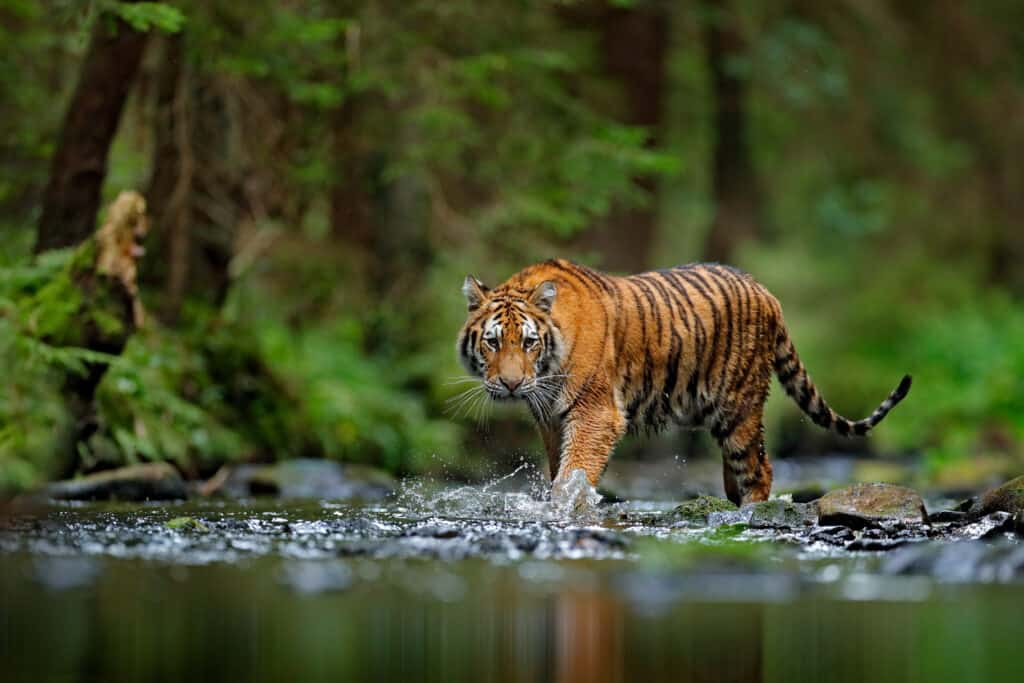
While both are camouflaged, apex predators, tigers and polar bears are different in how they navigate and survive their environments.
©iStock.com/Ondrej Prosicky
There are myriad differences between these animals. They’re both well-camouflaged hunters, apex predators, rulers of vast territories, and incredibly well-suited to their natural habitats.
The thing is, they do all those things in wildly different fashions. Polar bears are white against blizzard-white conditions, blending into the snow apart from a black nose and dark eyes.
Tigers are striped and patterned in a way that’s adaptable across their habitat. It’s a multipurpose camouflage that happens to be strikingly beautiful. Still, it’s hard to miss a 400-pound tiger in the middle of the Arctic.
The animals also hunt differently. Tigers are ambush predators, while polar bears use a blend of tactics well-suited to the ice and snow of their environment. We’ll get into all these fine details in future sections.
What Are The Key Factors in a Fight Between a Tiger and a Polar Bear?
Both of the animals in question are large, skilled hunters. A hypothetical encounter between the two would involve numerous important factors.
The qualities of the individuals in question are very important. Are they male or female? Are they hungry or have they been fortunate enough to find a lot of food as of late? Is one uniquely large for its species?
Further, the arena is almost as important as the players. Whichever animal is closer to its home environment will have a sure advantage, although that advantage won’t guarantee the win.
Whoever starts the fight will have an upper hand as well, assuming they use the element of surprise. That first blow could be the most crucial factor in the outcome.
Let’s dive into these factors and weave through how things might go based on the differences and factors listed above.
Polar Bear vs. Tiger: Size
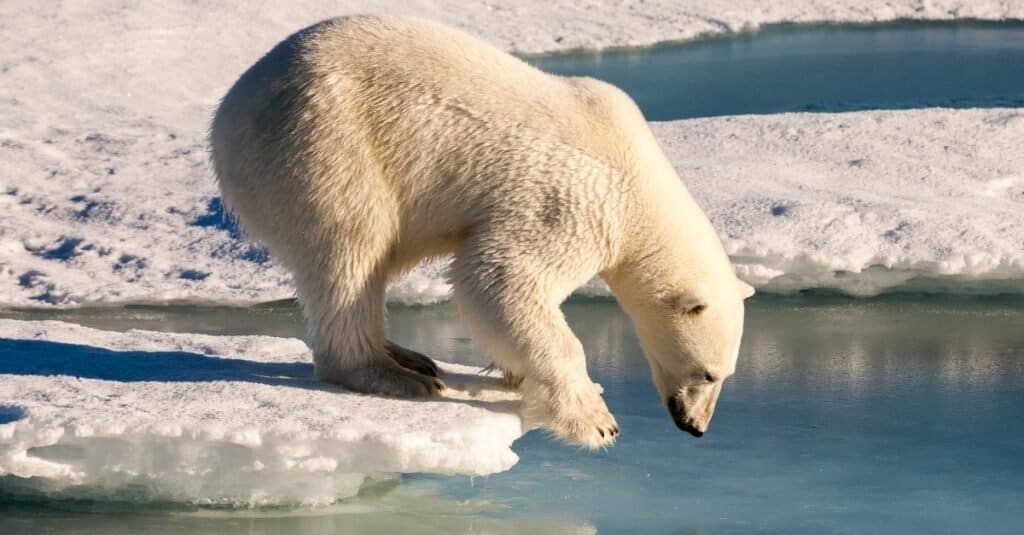
In terms of size, polar bears have an advantage over tigers.
©Mario_Hoppmann/Shutterstock.com
Male Siberian tigers typically weigh a little more than 400 pounds. Females weigh about 100 pounds less. The largest Siberian tiger on record weighed more than 900 pounds, but he lived in captivity and was fed a massive diet.
Wild tigers are forced to roam vast distances in search of prey, and their physical activity combined with food scarcity keeps them at much more modest weights.
Polar bears, on the other hand, are the largest land carnivores in the world. It’s not uncommon for a male polar bear to weigh more than 1,200 pounds. It’s also notable that polar bears have significantly different weights throughout the year, being heavier at the end of the summer hunting season than they are in winter.
Generally speaking, polar bears have the size advantage.
Polar Bear vs. Tiger: Hunting Style

Because tigers are more accustomed to preying on fast animals on land, their hunting style wins out over polar bears’ tactics.
©Martin Mecnarowski/Shutterstock.com
Polar bears tend to lay in wait for marine mammals, preying mostly on seals. They’re strong and smart enough to outwit and eat the occasional muskox or reindeer as well.
While hunting, they use their exceptional sense of smell and intelligence to pinpoint seals and either ambush or trap them on sheets of ice. When the time comes to get in the water, polar bears are also powerful swimmers.
They’re capable of chasing seals and other marine mammals under the water and latching them with their powerful bite force.
Siberian tigers, on the other hand, are masterful in different ways. These ambush predators prey on speedy land mammals such as deer, water buffalo, the occasional brown bear, and many more. That said, encounters with bears aren’t standard and typically occur under uncommon circumstances.
Because they’re more accustomed to hunting land prey, tigers have the hunting style advantage.
Polar Bear vs. Tiger: Speed

The speed advantage in this battle depends on the location. While tigers win on land, polar bears win in the water.
©Vladimir Gjorgiev/Shutterstock.com
Polar bears can really move well for their size. They’re able to lumber along at 25 miles per hour. Tiger speed estimates vary from 40 miles per hour to 60 miles per hour, depending on the resource.
In any case, that’s roughly twice the speed of a polar bear. On land, tigers have a clear speed advantage.
In the water, however, polar bears are going to come out on top every time. They can submerge, swim freely, move quickly, and even attack underwater.
Tigers are competent swimmers but they can’t move through the water as polar bears can. Polar bears could even swim away from a tiger for dozens of miles, returning once the tiger has lost its energy and given up.
The polar bear has the speed (and endurance) advantage in the water.
Polar Bear vs. Tiger: Attacks and Defenses
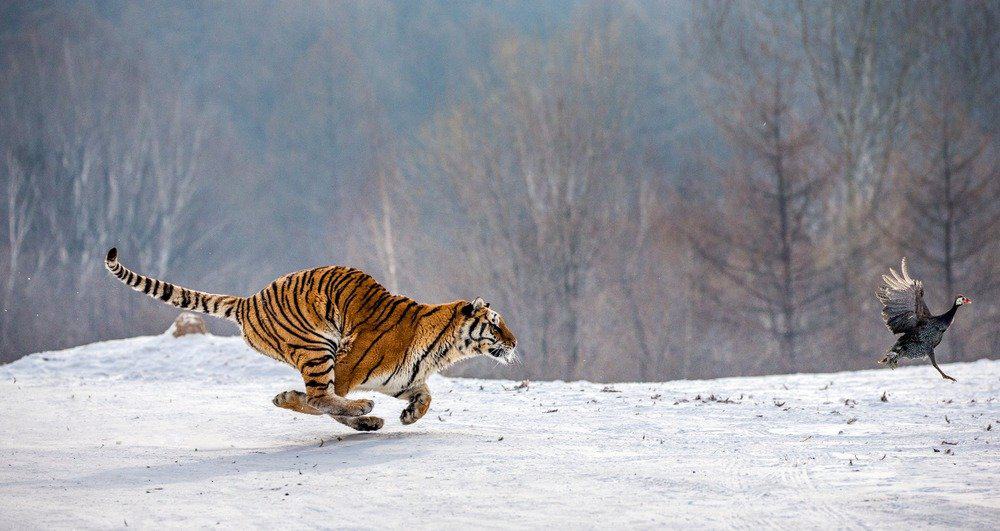
While both of these beasts fight over only short periods of time before their battles are ended, a tiger’s array of attacks is more valuable in a fight than a polar bear’s.
©GUDKOV ANDREY/Shutterstock.com
Tigers and polar bears both exist at the top of their respective food chains. That means that they have few, if any, natural predators.
Members of the same species are likely these animals’ largest threats, and same-species encounters are usually disputes over land, mates, and food. Those aren’t usually fights to the death, but rather competitions to see who is dominant.
Large male polar bears spar with the use of their forelimbs, teeth, and claws. They also use their stature and weight to assert dominance over competitors, standing tall and roaring as an act of intimidation.
These battles don’t typically go on for very long, however. Polar bears need to conserve energy, and the benefits of fighting are quickly outmatched by the benefits of preserving energy.
Sparring tigers, on the other hand, explode upon one another with incredible force. They bat at one another with strong and fast thrusts of the forelimbs, digging their claws in with each blow. They also use their forceful jaws to snap at one another in a whirlwind display of power.
Tigers, too, fight for short periods of time. Once the winner asserts dominance, the score is settled. There’s no need to kill the loser in most cases.
Tigers have an advantage in terms of attacks and defenses.
Let the Battle Begin
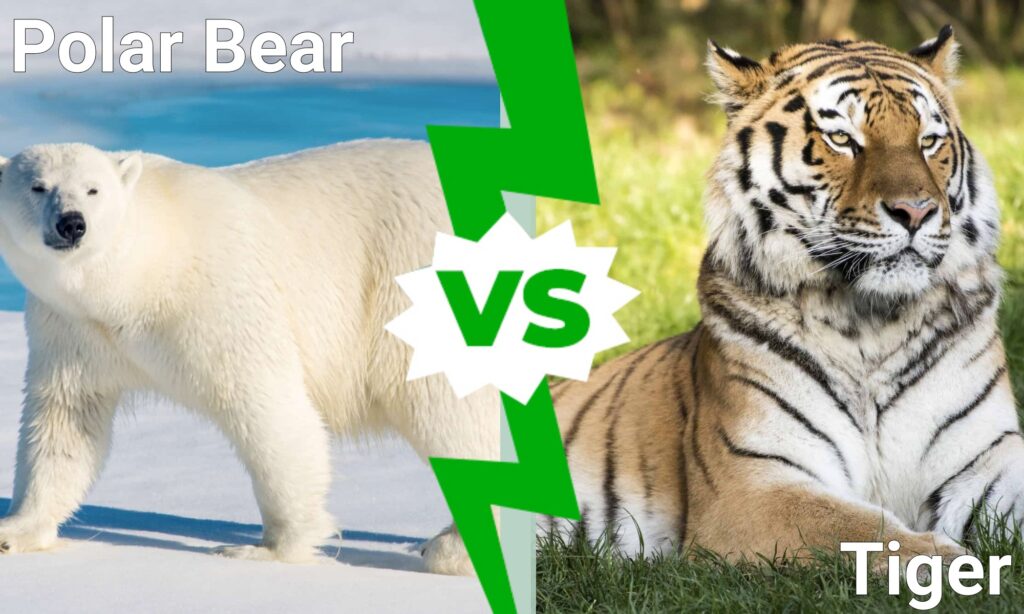
We’ve looked over all of the characteristics, but stats aren’t everything. Some of the greatest battles were won by players who, on paper, should have lost by a long shot.
The Siberian tiger and polar bear are pretty evenly matched, however. That means the context of the fight will play a huge role. The fighters themselves are going to be very important as well.
Let’s see how things pan out.
The Characteristics of the Individuals Are Key
Male and female polar bears fall at vastly different weights. Further, polar bears at the end of a long winter are much less powerful than individuals in the midst of a fruitful summer.
Similarly, Siberian tigers vary a great deal in size and ability. So, for the purposes of this battle, let’s say that both animals are healthy males of average size.
The tiger weighs 400 pounds and the polar bear weighs 1,000 pounds. They’re both well-fed and well-rested. Neither has any disabilities or injuries to contend with, and they’re both encountering the other species for the first time.
The Environment is Crucial
Polar bears rule over vast plains of ice and snow, whereas tigers mainly occupy jungles and forests. Those are very different terrains, and either animal would have the “home turf” advantage.
Polar bears would struggle in dense forests, whereas tigers might not be able to navigate ice sheets and frigid waters. The home-field advantage wouldn’t be everything, though.
Odds are that the animals would end up facing off on a firm patch of land or ice for the majority of their battle. If they broke apart to run and chase one another, the environment would come back into play heavily.
On the ice, the polar bear has a great advantage. Everywhere else, the tiger has the upper hand.
The Initial Strike Is Very Important
Who starts the fight? This makes a huge difference in the outcome, especially between two animals as formidable as the ones we’re discussing.
If a Siberian tiger were lounging on a patch of ice and a polar bear exploded from the water to initiate the fight with a bite or swipe of his massive paw, that first blow could be one of the most devastating hits of the battle.
But if the tables were turned and the tiger snuck up on the polar bear, that first bite might almost be enough to put the bear down altogether. If not, it would certainly play a part in the bear’s ability to fight from that point on.
Tigers are very specific and effective when they sink their teeth into prey. Considering that the tiger is faster, there’s a good chance the bear would be slain if he started to run in the opposite direction.
Would a Polar Bear or Tiger Win in a Fight?
It looks as though the tiger would win in most cases. Tigers have an advantage in terms of speed and skill, particularly on land.
Polar bears are exceedingly powerful and much larger than tigers. Still, the polar bear is built to hunt and thrive in the Arctic. Tigers are capable of outperforming animals in nearly any biome.
Their speed, stalking ability, and experience hunting large land mammals give them a serious upper hand, and that’s what makes us believe he would win against the polar bear.
In the frozen tundra of the Arctic Circle, polar bears would likely win the fight. The scale tips in favor of the tiger in every other environment.
Which Animal is More Vulnerable–the Polar Bear or the Tiger?
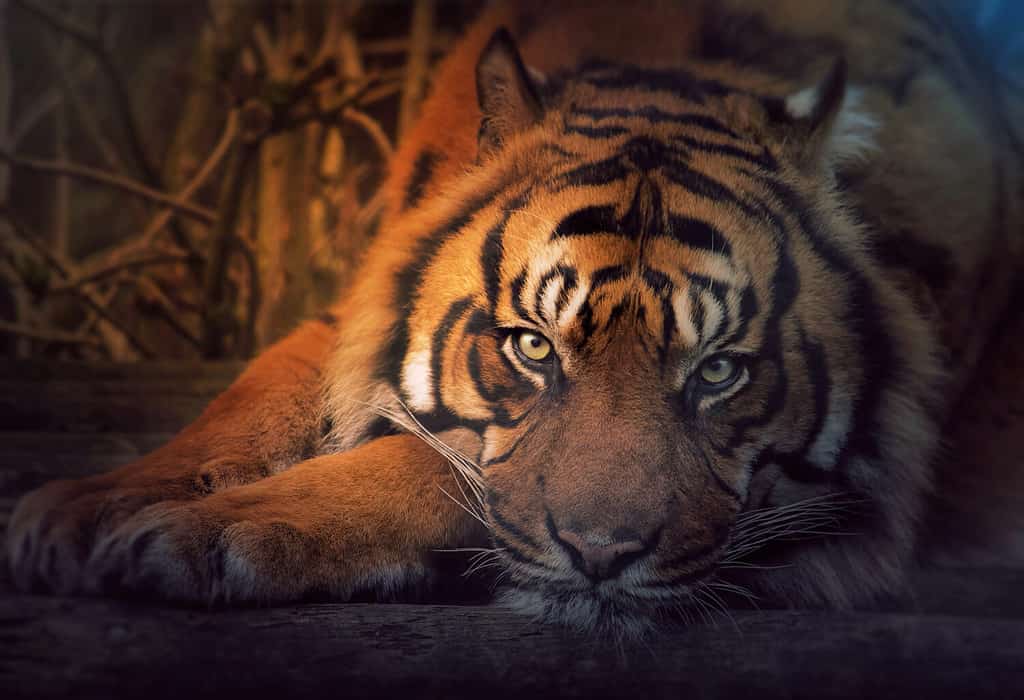
Sadly, tigers are listed as an endangered species by the IUCN, with only about 3,900 left in the world.
©Zita Stankova/Shutterstock.com
Which animal is more in danger of extinction–the polar bear or the tiger? Polar bears are listed as a vulnerable species by the IUCN. They have suffered a population decline that is mostly due to the loss of sea ice because of climate change. They estimate that there are 26,000 polar bears worldwide. Other threats to polar bears are habitat encroachment by humans, the commercial fishing industry, pollution, and more.
However, the plight of tigers is far worse, as the IUCN has labeled these massive beasts as endangered. Several sub-species of tigers have already gone extinct, and of those remaining, there are only 3,900 tigers still existing. They are most extant in India, where approximately half of the population lives.
To sum it up, in comparing the endurance of the polar bear vs tiger species, the polar bear outnumbers the tiger largely, but it is not a joyous victory, and both population statistics are tragic.
The photo featured at the top of this post is ©
Thank you for reading! Have some feedback for us? Contact the AZ Animals editorial team.






